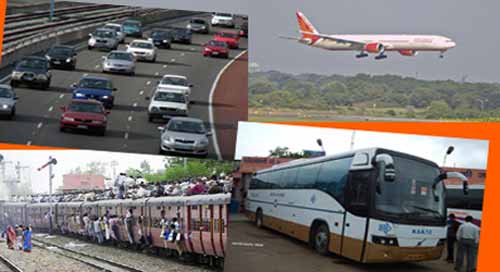How to Reach Jaipur The Rajasthan Pink City is an amalgamation of the modern and the old. It would amaze the first-time tourist to see lanky camels roaming along the side of the road as luxury buses speed by. Jaipur has all the tourist attractions one can dream of and yet what attracts tourists here is the heritage of the area. As you go on an elephant ride to the magnificent Amber Fort, You are still in for a rollicking time in Jaipur, wandering the nooks and corners of Hawa Mahal or gazing in awe at the celestial delights of Jantar Mantar.
When all of Old Jaipur’s houses were painted pink in honor of the visiting Prince of Wales in 1876, Jaipur received its moniker. Jaipur’s heritage attractions hold their own against the city’s bustling modernity and those against it.
Jaipur is the pinnacle of the Golden Triangle tour itinerary, along with Agra and Delhi. Commonly known as the gateway to Rajasthan, via a variety of modes of transportation, one can enter the Pink Area. It is easy to get to How to Reach Jaipur, but leaving can be challenging because you could just fall in love with the place!
How to Reach Jaipur
How to Reach Jaipur, renowned as the Pink City, is one of India’s most ancient and colourful cities. Serving as the capital of Rajasthan, Jaipur is home to architectural wonders such as the City Palace and the Amer Fort, and tourists from all over the city to see these beauties. Jaipur is well served by a number of trains and buses for flights, so getting here is not a challenge. Sanganer Airport (about 15 km away) and Jaipur Railway Station (about 5 km away), respectively, are the city’s own airports and railway stations. In addition, from neighboring cities such as Delhi, Agra, Kota and Alwar, a number of roadways and state buses ride.

By Air:
The closest domestic and international air base to Jaipur is Sanganer Airport. There is one terminal at the airport, Terminal 2, which services all national and international airlines. Daily flights from Delhi, Mumbai, Bangalore and Chennai to Jaipur are run by carriers such as Air Asia India, Air India, GoAir, SpiceJet, IndiGo and Jet Airways.International airlines have flights to Sharjah, Dubai, Abu Dhabi and Muscat, such as Air Arabia, Air-India Express, Ethihad Airways and Oman Air. Travellers can hire a taxi or cab to reach anywhere in the city after leaving the airport How to Reach Jaipur.
By Train:
There are three major railway junctions at Gandhinagar, Durgapura and Jaipur. This famous tourist place has been linked by Indian Railways with all the major cities such as Mumbai, Delhi, Kolkata, Chennai, Bangalore, Ahmadabad, Jammu, Kanpur, Bhubaneswar, Agra etc. How to Reach Jaipur is very well linked to other cities on a daily basis by big trains such as Shatabdi Express, Intercity Express and other Express trains.
At the Palace on Wheels, you will enjoy an exotic ride. For a week-long leisure trip, it arrives from Delhi and connects Jaipur, Sawai Madhopur and Chittorgarh, Udaipur, Jaisalmer, Jodhpur, Bharatpur and Agra.
By Road:
NH8, NH11 and NH12 are connected to Jaipur. Both AC Volvo and Non-AC Deluxe buses are available to and from Jaipur, run by the Rajasthan State Road Transport Corporation (RSRTC) as well as private agencies. You can also take a bus when you are in Jaipur from Narayan Singh Circle and Sindhi Camp.
- Delhi to Jaipur – 269 Km (4h 13 min via NH8)
- Agra to Jaipur – 237 Km (4h 15 min via NH11)
- Jodhpur to Jaipur – 338 Km (5h 8 min via NH112 and NH8)
- Bikaner to Jaipur – 343 Km (5h 20 min via NH11)
- Jaisalmer to Jaipur – 592 Km (8h 36 min via NH15 and RJ SH 19)
Popular Tourist Attraction in Jaipur
Jaipur is renowned for its magnificent architectural wonders, busy city life, exquisite handicraft pieces, intricately embroidered clothing, and rich culture and history, also known as the ‘Pink City’. With the grandeur and richness of the heritage of the Rajputana Maharajas of the past century, the whole city reverberates. Jaipur is one of the most popular and popular destinations for visitors And the home of some lovely palace hotels in the region. Hawa Mahal, Amber Castle, museums, shopping arcades, and, most notably, the City Palace are among the list of local attractions. Thus, to enjoy the glimpses of awesome royalty in India, visitors from far flung regions of India could How to Reach Jaipur.
Amber Fort
The Amber Fort, founded in 1592 by Raja Man Singh, is located some 11 km from Jaipur. Red sandstone and marble were used as building materials. Maotha Lake then strengthens the beauty of the majestic fort. The fort has stunning interiors with attractive buildings such as the ‘Sukh Mahal’,’ Diwan-i-Aam’ and ‘Sheesh Mahal’ in view of the old look from the outside. The confluence of both Hindu and Muslim architectural designs can easily be seen in the fort.
During the ruling era of Kachhwahas, Amer was known as Dhundar from the 11th century to the 16th century. In 1952 AD, the fort was designed by Raja Man Singh and later extended and restored by Raja Jai Sigh I. The fort was either replaced by an alternative or demolished by different old structures of the fort, withholding the fort to the test of time, climate and invasions. The fort is broken into 4 parts, each with a different entrance. The main entrance to the fort is through the ‘Suraj Pol’ Sun Gate.
Jantar Mantar
One of the largest observatories ever constructed is Jantar Mantar. A natural combination of science, art and religion is demonstrated by the collection of 5 majestic structures. These are situated in New Delhi, Varanasi, Jaipur, Mathura and Ujjan states. With the highest sundial in the world, Jantar Mantar was one of the tourist attractions.
‘Jantar Mantar’ is the name It is derived from words in Sanskrit which mean ‘Yantra’ means ‘instrument’ and ‘Mantra’ means ‘formula.’ The word ‘Yantra’ was later changed to ‘Jantar,’ meaning ‘magical.’ Therefore, this attraction has plenty of resources that grab the attention of architects, historians and astronomers from numerous parts of the globe How to Reach Jaipur.
Maharaja Jai Singh II, the founder of Jaipur,’ Pink City,’ founded a renowned observatory in 1718 and today the observatory is known as ‘Jantar Mantar.’ Here, 14 large geometric instruments are included in the astronomical observatory that could be used to track constellations, measure time, and even to follow the orbits around the sun. The structures are very common, such as ‘Samrat Yantra’ (the biggest sundial in the world),’ Jaiprakash Yantra’,’ Hindu Chhatri‘, etc.
City Palace
City Palace, nestled in the heart of ‘Pink City’ Jaipur, comprises ‘Mubarak Mahal’,’ Chandra Mahal’ and many other buildings that make up the beautiful palace complex. Sawai Jai Singh II, from 1729 to 1732 AD, designed this palace complex. Sir Samuel Swinton, Jacob and Vidyadhar Bhattacharya designed the architecture of the city. Thus, you can distinctly find glimpses of the Mughal, European and Rajput styles of architecture in the structures.
Maharaja Sawai Jai Singh II is said to have began the building of the City Palace Jaipur. He entrusted the job to the chief architect, Vidyadhar Bhattacharya, to plan the city palace complex. The construction of the city palace was then carried out in compliance with the texts of Vaastushastra.
There are glimpses of Mughal, European and Rajput designs when it comes to architectural decoration. ‘Jaleb Chowk’, ‘Virendra Pol’, ‘Tripolia Gate’, and ‘Udai Pol’ are the main gates of the City Palace. The palace is beautifully decorated and includes buildings such as ‘Mubarak Mahal’,’ Govind Dev Ji Temple’,’ Diwan-I-Khas‘ and ‘Chandra Mahal’ in ‘grid style’ and all the gates of the palace area. All these gates, representing the Mughal style of architecture, are built with lattice, mirrors and murals.
Hawa Mahal
The name suggests that it is a ‘wind palace,’ named so because this 5 level building consists of around 953 beautifully designed windows in a honeycomb style. This palace, overlooking the lively market street, is an elegant landmark and is an excellent example of Rajput architecture. Originally, this splendid building was constructed for the ladies of the royal family And take a look, without being heard, at the outer streets and processions. In 1799, King Pratap Singh built the Hawa Mahal, and now it is the city’s most visited site. From 9.00 am to 4.30 pm, the Hawa Mahal is open How to Reach Jaipur.
Jaigarh Fort
The fort of Jaigarh is one of the three hilltop forts overlooking Rajasthan’s capital city, Jaipur. The second one was built in the 18th century by Jai Singh, and the palace complex is named after him. The sophistication and fragile structure of this formidable fort does not exist, but it gives you a glimpse into the rough and military characteristics.
The name indicates ‘victory,’ originally constructed to defend the fort of Amer, which is linked by a passage and other structures. In the later years, Jaigarh Fort was declared an artillery warehouse, incidentally, it still exhibits some of the guns and gunneries in the museum of the fort. It is home to the largest cannon on wheels in the world and is considered to be a treasure spot. Beautiful parks and several lakes encircle this elevated fortification of dense red walls.
Jal Mahal
Its striking attribute simply suggests the word Jal Mahal, meaning water palace. Located in the center of Man Sagar Lake in the city of Jaipur, it gives tourists an excellent view. The Mughal – Rajputana style of architecture is demonstrated by Jal Mahal and the view is enhanced by the Nahargarh Hills backdrop.
The Jal Mahal’s original date of completion is not known, But it was revamped, the second by Maharaja Jai Singh in the 18th century. It is a tower of five tiers, built of red sandstone, but the four levels are immersed in the sea, causing only the top floor to be visible. The palace, particularly in the evening, looks amazing, one of the most glorious sights one can get from a trip to Jaipur.
Nahargarh Fort
Nahargarh means’ tiger’s abode ‘and a legend says that it is named because the palace was haunted by a Mahar Singh Bhomia ghost. The fort and the other two were built to defend Jaipur along the Aravali hills: Amer Fort and Jaigarh Fort. In the 18th century, the second was built by Maharaja Sawai Jai Singh and used as a retreat centre. From this fort, one can have a magnificent view of the whole city. The interior is elegant with a cluster of many similar suites made for the royal members, with corridors linking all the rooms.
